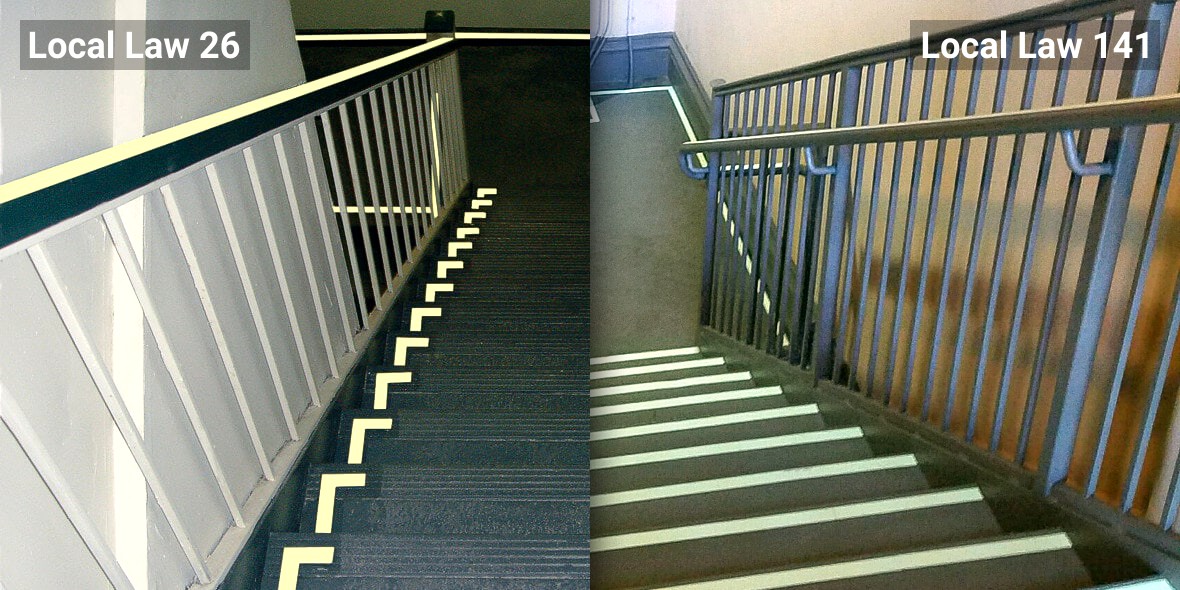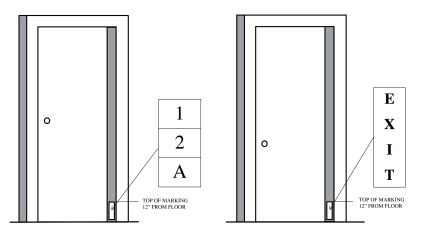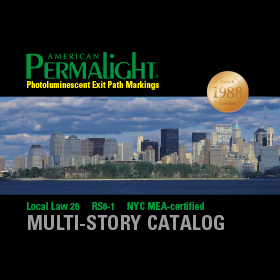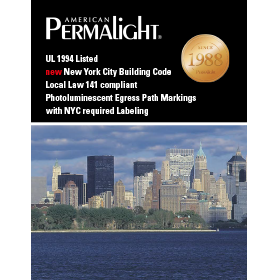
New York City Local Laws
Read on to learn about how different New York City Local Law 26, MEA-certified Exit Path Markings are to NYC Local Law 141, UL1994-listed Egress Path Markings and the most recent NYC Local Law 3 RCNY §505-01 and 3 RCNY §505-02. All markings help guide your building occupants out to safety but with a different set of requirements.Video
Permalight® Proven Photoluminescent Performance
In 1994, following the first terrorist bomb attack in the World Trade Center basement parking garage, the Port Authority of New York and New Jersey installed Permalight® photoluminescent markings on the steps, landings and handrail top bars of their emergency staircases. Click here to learn more about the original Permalight® WTC installation in 1994. Seven years later, during the 9/11 World Trade Center New York City evacuation, 33% of survivors in WTC Tower I and 17% of survivors in WTC Tower II were aided by the Permalight® photoluminescent markings on the steps, landings and handrails. Learn about the NIST (National Institute of Standards and Technology) investigation at nist.gov. Based on the NIST findings, the New York City Department of Buildings developed a range of improvements, enforced by Local Law 26 of 2004, which included photoluminescent exit path markings on doors leading to exits and in emergency staircases of existing High Rise Office Buildings 75 feet or taller. The New York City Building Code required that certain materials and equipment were accepted by the NYC Department of Buildings. Accepted products were given an MEA (Material and Equipment Acceptance) Number by the MEA Department. NYC Reference Standards RS6-1 and RS6-1A from 2005 detailed:- where the photoluminescent exit path markings have to get installed
- what the signs and markings look like, including at that time newly invented L-shaped Step Markers
- which tests the signs and markings had to pass to obtain the prestigious MEA number
- how each sign and marking has to be labeled for AHJ (Authority Having Jurisdiction) MEA number verification after installation
Late December 2013, Mayor Bloomberg signed several new Local Laws that took effect December 31, 2014. Feel free to download the new “Local Law 141 of 2013” here: nyc.gov.
You find the Photoluminescent Sections in:
- 1024 (starting on Page 778) Luminous Egress Path Markings
- 1022.8.6 Stair ID Signs and
- Appendix S for the photoluminescent requirements for NEW Construction and Major Alterations in all High-Rises (except Condo/Apartment)
New Buildings – Alterations to existing buildings
If you submitted your Construction Documents for- NEW high-rise hotel / motel, office / administrative, hospital buildings on or after October 1, 2014,
- Alterations to Existing high-rise hotel / motel, office / administrative, hospital buildings on or after October 1, 2014,
| Comparison | Local Law 26: MEA | Local Law 141: UL1994-listed |
| Activation | 2 foot-candles of activating lighting | 1 foot-candle of activating lighting |
| Length of Activation | 120 minutes | 60 minutes |
| Marking of Steps | L-shaped Step Markers | Continuous full step width marking |
| Handrails | Were not required to be marked | Must be marked |
Do you need Signs and Markings per Local Law 3 RCNY §505-01 and 3 RCNY §505-02 to mark Group R-1 Hotel/Motel and Group R-2 Apartment Unit door frames?
 FDNY (Fire Department of New York) published its Rule 3 RCNY 505-01 & 3 RCNY 505-02 requiring residence door frames, egress stair door frames and duplex & triplex door frames be marked with photoluminescent, retroreflective or other approved material markings, plus wayfinding markings in certain locations if your building is not fully sprinklered.
R-1 Occupancy Type includes Hotels + Motels.
R-2 Occupancy Type includes Apartments, Boarding Houses, Dormitories and similar occupancies.
Call or email us, if this applies to YOUR property.
FDNY (Fire Department of New York) published its Rule 3 RCNY 505-01 & 3 RCNY 505-02 requiring residence door frames, egress stair door frames and duplex & triplex door frames be marked with photoluminescent, retroreflective or other approved material markings, plus wayfinding markings in certain locations if your building is not fully sprinklered.
R-1 Occupancy Type includes Hotels + Motels.
R-2 Occupancy Type includes Apartments, Boarding Houses, Dormitories and similar occupancies.
Call or email us, if this applies to YOUR property.






